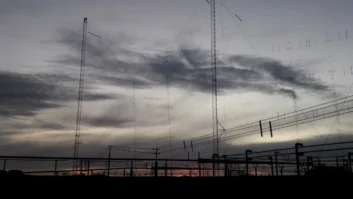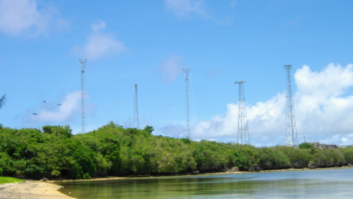Numerous commenters have told the FCC that a proposal to “modernize” the shortwave band is a threat to amateur radio operators in the United States and possibly the end of ham radio as we know it. And hams are just one source of opposition to the idea.
The FCC inquiry was prompted by a request from the Shortwave Modernization Coalition for a rulemaking to amend the Part 90 rules.
SMC believes there is underutilized spectrum in the high-frequency bands. The coalition wants to use 20 kW transmitters for the transmission of time-sensitive data from fixed stations. It wants the FCC to allow these fixed, long-distance, non-voice communications in multiple bands between 2 MHz and 25 MHz.
Ham opponents worry about interference. One also characterized the coalition as being “packed with special interest groups that harbor little interest in shortwave modernization beyond their own needs to getting faster financial market information.”
The commission’s Office of the Managing Director sought comments on its proposal this summer. The petition, RM-11953, drew more than 800 comments.
“Significant” interference
Financial traders have been using shortwave links for several years under experimental licenses granted by the FCC to send data between U.S. and foreign exchanges in the band’s Industrial/Business Pool frequencies. The coalition seeks a permanent solution including business licensing of commercial activities.
The proposal would prohibit voice transmission and mobile operations. But while it excludes amateur bands, it does involve high-power operations on spectrum adjacent to frequencies used by the Amateur Radio Service, according to people watching the issue.
Opponents say this would put hundreds of thousands of licensed American amateur radio operators at risk of receiving interference, while SMC believes any interference would be significantly below the noise floor.
Some commenters also said the petition fails to provide complete disclosure of the actual effective radiated power of those 20 kW transmitters, which they say could exceed 200 kW thanks to antenna gain.
The American Radio Relay League called the proposal seriously flawed.
“Many of the subject Part 90 bands are immediately adjacent or very near to spectrum bands that are allocated to the Amateur Radio Service on a primary basis,” ARRL wrote.
“These bands are very heavily used for worldwide communication by amateur radio licensees employing significantly less power than that proposed by SMC for purposes that include vital support during disaster recovery and mitigation, technical and scientific experiments, and propagation studies.”
ARRL says its laboratory conducted a detailed technical review over several months to determine if the proposed rules would affect radio amateurs.
“ARRL’s analysis determined that, if the proposed rules are adopted, the new operations inevitably will cause significant harmful interference to many users of adjacent and nearby spectrum, including amateur radio licensees.”
AARL adds: “SMC also proposes to substantially lessen the protections required to protect adjacent and neighboring licensees … using digital schemes with 50 kHz bandwidths and 20,000 watts of power.”
Hundreds of licensed amateurs filed comments in the docket, expressing overwhelming opposition for various reasons.
“Frequent solar emissions introduce noise in the shortwave bands that will likely interfere with these proposed signals, making them unusable for the purpose of reliably providing high-speed transmission of financial data,” wrote ham Robert Kirkland Smith. “I think the coalition would be better served to stay with the more secure and noise-resistant means of fiber-optic systems for their data transmission needs.”
Another commenter from the amateur community said the FCC’s ability to track and solve any possible interference issues is severely lacking.
“The commission is already overtaxed to resolve a variety of spectrum interference complaints from a variety of existing users,” wrote Lee F. Ilse. “Given that the requested authorization for higher-power transmissions is virtually guaranteed to cause additional interference, I respectfully suggest it would be highly irresponsible for the commission to adopt the suggested changes without a significant increase in resources dedicated to enforcement.”
Longtime ham Joseph Lee McLaughlin told the FCC: “Radio amateurs will encounter considerably more difficulty communicating over these bands. The effect of spurious emissions and interference from the high-power digital transmissions … exhibit a moderate level of harmful interference to most amateurs who use the portions of the radio spectrum adjacent to these transmissions,” he wrote.
“The most harmful interference will occur with marginal operators and marginal operating conditions such as long-distance, transcontinental and DX operations.”
One commenter suggested using a “guard band equal [to] or greater than the transmission bandwidth between the edge of the signal and the edge of the land mobile band.” Another veteran ham said the 20 kW power suggested by SMC “is truly overkill for digital signals.”
[Sign Up for Radio World’s SmartBrief Newsletter]
“Force multiplier”
There are others who took aim at the financial companies in the coalition, citing ethical concerns.
“The question before the commission is whether this proceeding really serves a public interest or merely enables a very small number of individuals and firms to further enrich themselves at the expense of consuming actual bandwidth and raising the noise floor of adjacent bandwidth. I am inclined to think the public interest is not well served in this case,” wrote Frederick L. Stiles.
Then there is the public service aspect of ham radio, a core value for many amateurs.
“Ham operators are more than just hobbyists, we serve as a force multiplier for emergency communications in the event of emergencies,” wrote Cian McCarron.
“We serve in communities throughout the U.S. and every tool at our disposal is important, including the very airwaves we use. We are also instrumental in the development of new technologies that help push the boundaries of communication and we are already limited in our bandwidth, not just by our own licensee levels, but by that which is allocated to us, something we must protect to the best of our abilities.”
One community radio advocate thinks there has been an overreaction to the possibility of interference. REC Networks told the FCC the plan is “ambitious” but would not “steal” spectrum from hams.
“For nearly a century, stations in the HF spectrum, including those with power and bandwidth that are equal or exceeding what SMC is proposing, have been operating in their appropriately allocated bands without interference to users of the HF spectrum in other bands and modes,” REC stated in its comments.
“The conspiracies raised by some members of the ARS community are more tied to their political opposition to the financial and technology industries than it is cemented in daily practice and the International Radio Regulations.”
Nevertheless, REC opposes the petition, because “when all else fails, HF spectrum is available for emergency communications in order to relay information to/from an area affected by an emergency, answer calls of distress and to assure the health and welfare of any person who is physically located in an affected area in the aftermath of a natural or man-made disaster.”
Skywave Networks, a shortwave radio technology company, told the FCC it sees tremendous potential in the productive use of shortwave for long-distance, specialized, data transfer and supports the commission’s efforts to open eligibility. However, “the commission must carefully consider an appropriate regime for the licensing of the 2–25 MHz band, including smaller limits on bandwidth and greater protections for co- and adjacent-spectrum users,” the company wrote.
SMC argues that its proposed amendments to high-frequency rules would enhance the ability of users to quickly access “real-time financial data and continue to act in a manner to improve asset prices, to the benefit of centralized markets and market participants.”
Speaking out
The firms that make up the coalition are “market makers and liquidity providers” for exchanged-traded financial instruments. The coalition includes DRW Holdings, IMC Trading Group, Virtu Financial Inc., NLN Holdings, Optiver Services and Tower Research Capital.
The coalition believes that its changes also have the potential to spur additional innovations in the use of the 2–25 MHz Band frequencies. The petition claims it will be possible for their operations to coexist with other band licensees and said its own technical study supports that.
But it’s not just hams that have expressed concerns.
The United States Coast Guard, the principal federal agency responsible for maritime mobility, safety and security, told the FCC that the Maritime Mobile Service or MMS is used extensively in multiple bands between 2 MHz and 25 MHz, and important for communications that go beyond line-of-sight.
In its opposition, the USCG said the proposed new data service will likely result in a “high use percentage as the market makers and liquidity providers update their bid/ask price continuously based on the most up-to-date information.”
The Coast Guard is also concerned about cybersecurity issues “such as spoofing or jamming” that could cause interference with MMS.
NCTA–The Internet & Television Association told the commission that cable providers use 2–25 MHz for broadband and television services. It worries about disruption and degradation to those services, which they say the coalition doesn’t mention, and would make the band inhospitable for current users.
It said one experimental licensee already disrupted commercial broadband and video service. “Comcast has directly experienced multiple occurrences of service disruption from one member of petitioners’ coalition,” the NCTA wrote, “caused by the exact type of operations petitioners are proposing here as a new licensed service.”
NTCA continued: “Each disruption resulted in customers experiencing packet loss, increased latency, slower and spotty broadband internet service, video channel changes and the inability to utilize certain Comcast devices with their services. This kind of disruption can also cause significant degradation to VoIP calls, including potentially for 911 calls.”
NCTA goes on to detail a disruption in the Seattle area in 2022 and another in a more rural part of Washington state this year.
And an extensive filing in opposition was submitted by Alex Pilosov, founder and president of Shortwave Solutions. Pilosov presented detailed data and exhibits criticizing the coalition’s request.
He says he is a consultant for a non-coalition company and that he manages system design and construction of an operational system that he described as the fastest operational HF connection on the Chicago-London route.
“Importantly, this lower-latency system operates with a spectrum efficiency that is over 1,000 times better than what the petition is seeking,” Pilosov writes.
He says the coalition’s request “is premature, incomplete and poorly thought out, and against the public interest,” and that its “lack of substance is matched by its audacity.”
Pilosov concluded: “(The) coalition’s petition is extraordinary in its scope, and if granted, would result in loss of spectrum availability worldwide, turning the critical Fixed Service spectrum into a CB-radio free-for-all loudness contest.”




